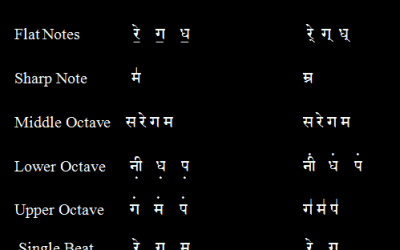Indian Swara Octave Development
The Swara Octave which is clarified in India is from Sa to Ma, the order of interval. It is important to understand for prior students of music in the context of Indian Swara Octave development, that Swara Octave categorised by Bharat is similar to present ‘Kaafi thaat’. So it is said that wherever Bharat Muni’s Shudh Swaras used in Script they should be used as Bhatkhande Script with the addition to Komal swaras with their respective symbol.
Development of Shadaj Gram Swaras of Bharat Muni
It was seen that Pa is the fifth Swara from Sa to Pa, similarly from descending order, Upper Sa coming to Pa, again happens to be the fifth Swara. This interval is called Guru Swara. This interval is present between every two swaras. There was 9/8 interval gap between Ma and Pa, similarly in Ma and Ga. If 9/8 interval is subtracted from Upper Sa we are able to reach at Ni. Therefore the interval of 9/8 is constant between the Swaras and is thus called Guru Swara. But two swaras were yet to be discovered, Re and Dha. The sign of these swaras was found in ancient texts where swaras like ‘Antar Ganthar’ and ‘Kakli Nishad‘ were found. It was said that ‘Antar Gandhar ‘ was found by adding two shrutis on Ga and Ma was found by subtracting two shrutis in the same order. Therefore it could be said that ‘Antar Ganthar ‘ was placed in the middle of Ga and Ma. Similarly ‘Kaaklu Nishaad‘ be found between Taar Sa and Ni. On the basis of this method, the interval can be seen between Ga-Ma and Ni – Taar Sa.
Recognition of Bilaaval thaat
It can be said that according to ancient scholars, Kaafi has been one of the first thaat. But it is predicted that Ahobal in 1615 explained about Bilaaval thaat. Even this thaat has been written about by Pythagoras and some foreigners.
Even in classification by Bharat Muni of Kaafi , if Ni is added in Arooh of the gram it becomes Bilaaval thaat.
Even in certain parts of India, prime importance has been given to Bilaaval thaat for being the first researched thaat.
Therefore, In Hindustani Sangeet, bilaaval thaat was only considered pure thaat.





0 Comments